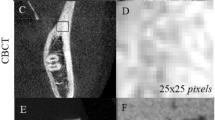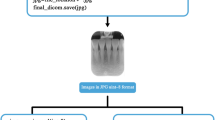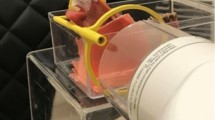Abstract
Objectives
The aim of this study was to evaluate the effect of exposure time and image resolution on fractal dimension (FD) of periapical bone on images obtained using a storage phosphor plate (SPP) system.
Materials and methods
Periapical images of premolar and molar teeth on both sides of ten dry human mandibles were obtained with Digora Optime (Soredex Corp., Helsinki, Finland) SPP system. The SPPs were exposed with three exposure times (0.05, 0.12, and 0.30 s) and scanned immediately after exposure with high and super resolutions. FD was calculated using public domain software (ImageJ with FracLac plug-in) on two non-overlapping region of interest (ROIs) on premolar and molar periapical bone areas of each radiograph using differential box-counting method. The ROIs on corresponding images were of the same size and position. FDs were compared using two-way ANOVA and Tukey–Kramer multiple comparison tests (p = 0.05).
Results
Images obtained with super resolution scans gave significantly higher FD values compared to high-resolution scanning for all exposures (p < 0.0001). FD values were decreasing with increase in exposure time for both resolutions (p < 0.0001). The highest FD was found for images with super resolution and shortest exposure time, which exhibited the highest noise.
Conclusions
FD analysis seems not so robust method as it was believed previously. It shows significant changes with image resolution and exposure time.
Clinical relevance
Exposure time and scanning resolution of SPPs should be carefully chosen when evaluating the change in FD of alveolar bone for various bone disorders.
Similar content being viewed by others
Explore related subjects
Discover the latest articles, news and stories from top researchers in related subjects.Avoid common mistakes on your manuscript.
Introduction
Computer-aided image analysis is extraction of meaningful information from digital images by means of digital image processing techniques. Fractal dimension (FD) calculation has become a popular analysis method to characterize image textures. It has been used on periapical and panoramic radiographs as a descriptor of the complex architecture of cancellous bone surrounding teeth [1, 2]. With introduction of digital dental systems, it has become even more feasible as digitalization of film is no longer needed. In dentistry, FD calculation has been performed on non-standardized radiographs for assessment of dental implant sites [3], evaluation of root canal therapy [4], and detection of many systemic pathological conditions such as osteoporosis [5] and sickle cell anemia [6]. According to the results of early studies, FD calculations were considered to be insensitive to variations in film exposure, alignment, and region of interest (ROI) placement [2, 7]. Later, two consecutive studies by the same group of researchers reported that FD is affected by the size, shape, and location of ROI [8, 9]. In recent studies, the information available with regard to the robustness of this technique was rare and inconsistent. Chen and Chen demonstrated significant change in fractal dimension with projection geometry [10], while Pornprasertsuk et al. and Bollen et al. showed that different types of image receptors significantly affect estimates of FD [11, 12]. In contrast, a recent study proved that variations in radiographic settings including tube potential, impulse, and cone angulation have a minimal impact on the fractal dimension [13].
Contemporary digital dental systems have wide range of technical specifications [14] and many of them provide options to acquire images at different resolutions. For storage phosphor systems (SPP), the resolution is determined by the scan speed of the scanner. The slower the scan speed, the higher the spatial resolution. It was clearly established that the higher the spatial resolution, the smaller the radiographic details that can be observed [15]. Although there were many studies that have tested the problems that hinder an effective texture analysis in medical images [16–18] no studies were done to test the effect of image resolution and exposure of intraoral digital images on FD calculation.
The aim of this study was to evaluate the effect of exposure time and image resolution on FD calculation of periapical bone on images obtained using a SPP system.
Materials and methods
Radiographic technique
Dry human mandibles, containing premolars and molars with no restorations or previous root canal therapy were selected to ensure absence of periapical pathology. Ten mandible posterior segments were used in the study. An optical bench was used to standardize projection geometry. Specimens were radiographed with size 2 (31 × 41 mm) blue storage phosphor plates (SPPs) of Digora® Optime (Soredex Corporation, Helsinki, Finland) system. A Gendex Oralix DC (Gendex Dental Systems, Milan, Italy) dental X-ray unit was operating at 60 kVp, 7 mA, and 1.5 mm Al equivalent filtration, a focus-receptor distance was 25 cm. Image plates were exposed with three exposure times (0.05, 0.12, and 0.30 s) corresponding consecutively to underexposed, exposure baseline, and overexposed for SPPs. Plates were scanned immediately after exposure using a Digora® Optime scanner with “super” and “high” (names will be used without quotations in the following text) resolution with 651 and 397 dpi, respectively. Automatic grayscale adjustment implemented in scanner software, was used during image acquisition. In total, 60 images were obtained and saved in uncompressed TIF format with Digora for Windows software (Soredex Corporation, Helsinki, Finland).
Fractal dimension calculation
On each image, two non-overlapping rectangular ROIs were selected in periapical trabecular bone not including roots or periodontal space. Positions and sizes of ROIs were determined according to the size and shape of the periapical region resulting in sizes ranging between 3.8 and 118.2 mm2 (Fig. 1). Wide range of ROI sizes was included to make the result independent of area size. Position and size of each ROI in corresponding images with different resolution and exposure was identical. A total of 120 FD calculations were done on 60 images. FD of all ROIs was calculated with public domain Image J software (http://rsbweb.nih.gov/ij/) and FracLac plug-in (http://rsbweb.nih.gov/ij/plugins/fraclac/FLHelp/Introduction.htm), which is implementing a differential box-counting method [19], developed for analysis of grayscale images. Maximum box size was 45% of each ROI and ranged from 5 to 57 pixels, depending on the ROI size; minimum box size was always two, and box series was linear. These parameters were independent from resolution and exposure. For each of the four calculations, a different part of ROI was used and it represented 45% of the ROI, as explained above. FD of each ROI was determined as the mean of the four calculations inside the ROI.
Statistical analysis
Fractal dimensions of ROIs from images with different exposure times and scan resolutions were compared using two-way ANOVA test (p = 0.05). Post-hoc pairwise comparisons between FDs from different images were made with Tukey–Kramer multiple comparison tests (p = 0.05).
Results
FDs from images obtained from super-resolution images were significantly higher compared to FDs obtained from high-resolution images (p < 0.0001). Images obtained with super-resolution scanning gave significantly higher FD than high-resolution images for all exposures (p < 0.05) (Fig. 2). FD of different exposure times were significantly different as for both resolutions as well (p < 0.0001). Tukey–Kramer multiple comparisons test revealed that FD values of images obtained with 0.05 s exposure were significantly higher than images obtained with 0.12 s (p < 0.05) and 0.3 s (p < 0.001) exposures. However, no difference was found in FD of images exposed with 0.12 and 0.3 s at both resolutions (p > 0.05).
Discussion
In Digora Optime scanner, the image resolution is determined by a scanning speed of SPP. The slower the scan speed (longer the scan time), the higher the resolution. The device provides two resolutions, namely “super” and “high” resolution. Higher FD was found for super resolution and this was true for all exposure times used in the present study. This is in accordance with results of mathematical simulation study [17], predicting that FD increases with an increasing resolution, as more details are depicted. Similar results were obtained in a study comparing the difference in FD using periapical and panoramic radiographs [11].
Digital images contain image noise of various levels which might arise from fluctuations in X-ray photons, low radiation doses, instability or deficiencies in the detectors’ electronics. It was demonstrated that noise reduces the discriminative performance of texture analysis in radiographs which in turn may reduce the diagnostic accuracy, and hence have a negative impact on the overall prognosis [17]. This study was performed using three different levels of exposure times (low to high) with two interchangeable spatial resolutions. It is well-known that the higher spatial resolution, the smaller the radiographic details that can be observed [15]. However; the spatial resolution is typically limited by the noise level.While increased resolution enables observing smaller details [20], increasing spatial resolution or lowering the exposure time results in higher level of noise in the resultant images [21, 22]. In the present study, SPPs scanned with super (higher) resolution results in images with smaller pixel size but higher noise level. In mathematical simulation [17], increase of image noise was predicted to increase FD; therefore, increase of FD of super-resolution images obtained in the present study can be partially attributed to the higher noise level However, it is not possible to compare this result since this is the first study demonstrating the effect of resolution and accordingly the noise on FD calculations using intraoral SPP images
As already mentioned above, increase in noise also results from reduction of exposure time. Optimal exposure times recommended for Digora SPPs were reported to vary between 0.02 and 0.13 s [23]. It was demonstrated that noise increases with decrease of exposure time in SPP systems [24] and according to the results obtained, FD increases as the exposure time decreases for both resolutions. If the two parameters, i.e., exposure time and resolution, tested in this study were evaluated with regard to noise, it is possible to conclude that findings supplemented each other. As exposure time decreases and resolution increases, signal-to-noise ratio decreases and FD gets higher in noisy images. As already mentioned above, this result is in accordance with results of studies that calculated FD using medical images [17], but somehow, contrary to the results of two studies in dental literature that evaluated the effect of exposure time on FD calculation and both reported no change in FD with changing exposure time [2, 13]. Shrout et al. reported that exposure time had minimal but insignificant effect on FD and found that FD of 1.0 s exposure was higher than 0.2 and 0.6 s [2]. It can be seen that they used almost double amount of exposure time than the baseline (0.12 s) and overexposure (0.3 s) times used in our study. Similarly, we could not be able to demonstrate any difference in FDs of SPP images exposed for 0.12 and 0.3 s since the noise do not decrease linearly with increasing exposure time [14]. In both studies, digitalization of the conventional films was utilized which may also have an impact on the image noise and accordingly FD calculations. In addition, both studies [2, 13] used different methods for FD calculation other than the box-counting method.
Originally, a box-counting method for FD calculation was developed for analysis of binary images. As radiographs are grayscale images, they must be converted to binary images before fractal analysis was performed. The process, precisely described by White et al. has several steps [5]. To facilitate the fractal analysis in various application fields employing grayscale images, a modification of box-counting method, namely differential box-counting method was proposed [19]. It was proved that the differential box-counting method has more precise estimated value of fractal dimension [25]. In biomedicine, it has been used in ultrasonography for characterization of salivary gland tumors [26].
In conclusion, FD analysis seems not so robust method as it was believed previously. It shows significant changes with image resolution and exposure time. Both factors have influence on image noise as it increases with increase of resolution and decrease of exposure time. Therefore, exposure time and scanning resolution of SPPs should be carefully chosen when evaluating the change in FD of alveolar bone for various bone disorders.
References
Geraets WG, van der Stelt PF (2000) Fractal properties of bone. Dentomaxillofac Radiol 29:144–153
Shrout MK, Potter BJ, Hildebolt CF (1997) The effect of image variations on fractal dimension calculations. Oral Surg Oral Med Oral Pathol Oral Radiol Endod 84:96–100
Wilding RJ, Slabbert JC, Kathree H, Owen CP, Crombie K, Delport P (1995) The use of fractal analysis to reveal remodelling in human alveolar bone following the placement of dental implants. Arch Oral Biol 40:61–72
Yu YY, Chen H, Lin CH, Chen CM, Oviir T, Chen SK, Hollender L (2009) Fractal dimension analysis of periapical reactive bone in response to root canal treatment. Oral Surg Oral Med Oral Pathol Oral Radiol Endod 107:283–288
White SC, Rudolph DJ (1999) Alterations of the trabecular pattern of the jaws in patients with osteoporosis. Oral Surg Oral Med Oral Pathol Oral Radiol Endod 88:628–635
White SC, Cohen JM, Mourshed FA (2000) Digital analysis of trabecular pattern in jaws of patients with sickle cell anemia. Dentomaxillofac Radiol 29:119–124
Ruttimann UE, Webber RL, Hazelrig JB (1992) Fractal dimension from radiographs of peridental alveolar bone. A possible diagnostic indicator of osteoporosis. Oral Surg Oral Med Oral Pathol 74:98–110
Shrout MK, Hildebolt CF, Potter BJ (1997) The effect of varying the region of interest on calculations of fractal index. Dentomaxillofac Radiol 26:295–298
Shrout MK, Farley BA, Patt SM, Potter BJ, Hildebolt CF, Pilgram TK, Yokoyama-Crothers N, Dotson M, Hauser J, Cohen S, Kardaris E, Hanes P (1999) The effect of region of interest variations on morphologic operations data and gray-level values extracted from digitized dental radiographs. Oral Surg Oral Med Oral Pathol Oral Radiol Endod 88:636–639
Chen SK, Chen CM (1998) The effects of projection geometry and trabecular texture on estimated fractal dimensions in two alveolar bone models. Dentomaxillofac Radiol 27:270–274
Bollen AM, Taguchi A, Hujoel PP, Hollender LG (2001) Fractal dimension on dental radiographs. Dentomaxillofac Radiol 30:270–275
Pornprasertsuk S, Ludlow JB, Webber RL, Tyndall DA, Yamauchi M (2001) Analysis of fractal dimensions of rat bones from film and digital images. Dentomaxillofac Radiol 30:179–183
Jolley L, Majumdar S, Kapila S (2006) Technical factors in fractal analysis of periapical radiographs. Dentomaxillofac Radiol 35:393–397
Attaelmanan AG, Borg E, Grondahl HG (2001) Signal-to-noise ratios of 6 intraoral digital sensors. Oral Surg Oral Med Oral Pathol Oral Radiol Endod 91:611–615
Li G, Berkhout WE, Sanderink GC, Martins M, van der Stelt PF (2008) Detection of in vitro proximal caries in storage phosphor plate radiographs scanned with different resolutions. Dentomaxillofac Radiol 37:325–329
Al-Kadi OS (2010) Assessment of texture measures susceptibility to noise in conventional and contrast enhanced computed tomography lung tumour images. Comput Med Imaging Graph 34:494–503
Veenland JF, Grashuis JL, Gelsema ES (1998) Texture analysis in radiographs: the influence of modulation transfer function and noise on the discriminative ability of texture features. Med Phys 25:922–936
Wenzel A, Haiter-Neto F, Gotfredsen E (2007) Influence of spatial resolution and bit depth on detection of small caries lesions with digital receptors. Oral Surg Oral Med Oral Pathol Oral Radiol Endod 103:418–422
Sarkar N, Chaudhuri BB (1994) An efficient differential box-counting approach to compute fractal dimension of image. IEEE Transactions on Systems, Man, and Cybernetic 24:115–120
Hildebolt CF, Bartlett TQ, Brunsden BS, Hente NL, Gravier MJ, Walkup RK, Shrout MK, Vannier MW (1994) Bitewing-based alveolar bone densitometry: digital imaging resolution requirements. Dentomaxillofac Radiol 23:129–134
Borg E, Attaelmanan A, Grondahl HG (2000) Image plate systems differ in physical performance. Oral Surg Oral Med Oral Pathol Oral Radiol Endod 89:118–124
Couture RA (2003) Comments on noise and resolution of the DenOptix radiography system. Oral Surg Oral Med Oral Pathol Oral Radiol Endod 95:746–751
Pfeiffer P, Schmage P, Nergiz I, Platzer U (2000) Effects of different exposure values on diagnostic accuracy of digital images. Quintessence Int 31:257–260
Berkhout E, Sanderink G, van der Stelt P (2004) Digital intra-oral radiography in dentistry. Diagnostic efficacy and dose considerations. Oral Radiology 19:1–13
Liu S (2008) An improved differential box-counting approach to compute fractal dimension of gray-level image. In: Yu F, Yue G, Chen Z, Zhang J (eds), vol 1. pp 303–306.
Chikui T, Tokumori K, Yoshiura K, Oobu K, Nakamura S, Nakamura K (2005) Sonographic texture characterization of salivary gland tumors by fractal analyses. Ultrasound Med Biol 31:1297–1304
Conflict of interest
The authors declare that they have no conflict of interest.
Author information
Authors and Affiliations
Corresponding author
Rights and permissions
About this article
Cite this article
Baksi, B.G., Fidler, A. Image resolution and exposure time of digital radiographs affects fractal dimension of periapical bone. Clin Oral Invest 16, 1507–1510 (2012). https://doi.org/10.1007/s00784-011-0639-3
Received:
Accepted:
Published:
Issue Date:
DOI: https://doi.org/10.1007/s00784-011-0639-3






